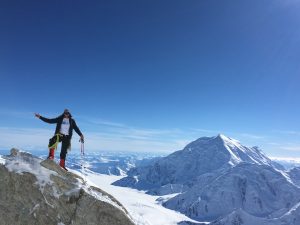
Author: Matt Knarsten (2018)
Check out my TEDx Talk Here!
Mountaineering is the sport of climbing mountains. It could also be known as slow walking uphill while not feeling very well, coupled with extended periods of intense boredom, often interrupted by moments of sheer terror. You might think there is very little sense in mountaineering, but there is one thing that binds this community together and what all mountaineers seek: ADVENTURE!
I began mountaineering seven years ago, through the New Zealand Alpine Club and have been climbing in North and South America, Europe and New Zealand, having just completed my most recent 19-day adventure on the highest mountain in North America, ‘Denali’ in Alaska.
So why bother listen to a guy that climbs a bunch of mountains?
While I have successfully summited several mountains, there have been plenty of unsuccessful attempts as well. It is true what they say – you learn from your mistakes. The mountains are a real-world training ground where making wrong decisions can lead to injury or death. This makes mountaineering an effective, yet ultimately unforgiving, teacher. There are many lessons that can be learned from the mountains and some of the best examples are the parallels that mountaineering shares with the business world.
Lesson #1: Preparation is everything, the plan is nothing
Most plans are useless as soon as they are put in motion. The real value of the original plan is the preparation of defining the goal or the outcome we desire to clarify the destination. When embarking on a big trip, it’s important to break down the climb into realistic steps. This is helpful for planning the trip (i.e. food, fuel and equipment requirements) and shifting the goal from being daunting to manageable. Similarly, you would not be able to execute a project without breaking it down to tasks and assessing required and available resources.
Ambition is great for business leaders, but remember that your team needs to be able to execute the vision. Mt Rainier is the highest mountain in Washington State at 4,392m. On both occasions, we got turned around because of poor and aggressive planning on my part and not assessing the whole teams strengths and weaknesses effectively, especially with regards to fitness and comfort with exposure.
Assessing the whole team for their strengths and weaknesses should be done early, as it is vital to be aware in your team’s expertise gaps and bridge these before you set off on your adventure. Whether the gaps lie in experience, technical knowledge or fitness, having upfront open and honest conversations about this sets your team up for success.
Lesson #2: Bigger isn’t always better
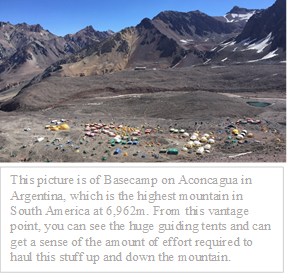
Expedition style is an approach to mountaineering that is very similar to the way that a lot of businesses are run today. It’s a powerful way to climb mountains, but it’s also very expensive, very inefficient and not particularly effective at adapting to changing conditions (e.g. weather). They are big teams, typically guided, and have a large reliance upon fixed infrastructure. You get told what clothing to bring by your guide, you’re provided your equipment, your food is cooked for you and water boiled, your daily activities are predetermined and any change in this schedule results in a potential failed summit attempt similar to expedition style, businesses that operate in this manner can be robust, but tend to suffer from bureaucratic processes and hierarchies, chronic inefficiencies, slow response times to change, and have a tendency to fail when significant unexpected events occur.
Another approach is alpine style or light and fast. These are small teams that carry only what is needed for the climb. The focus shifts from a siege mentality of “attacking” the mountain to a light and fast approach to the summit. Alpine style has many similarities to lean and agile project management as it is highly collaborative with no structural hierarchy and no central leader. Instead there is shared decision making responsibility; You are in a constant feedback loop because you’re the one making decisions, learning from your mistakes and 100% accountable. It’s an empowering approach to mountaineering.
Lesson #3: Surround yourself with people who are better than you
Teamwork is the ability to work together towards a common vision. The ability to direct individual accomplishments toward organizational objectives. It is the fuel that allows common people to attain uncommon results.
- Teamwork produces results – It’s almost impossible to climb many mountains without a team. Mountaineers need to trust their life with their team and know when to ask for help. Similarly, in business, don’t feel too proud to ask for help when you need it. It’s a team that makes an organization successful, not individuals
- Seek people that ooze positive energy – You’re going to need optimistic people around you during the tough times when your reserves are running low
- Like your team – You’re going to be stuck together for a long time!
In Alaska, having a strong team is crucial. It’s one of the coldest places on earth with tons of objective danger all around you. Around this point on the Kahiltna Glacier a lot of people fell into crevasses while we were on the mountain, with one chap even needing the US army to assist in his rescue. At one point when we were crossing a crevasse, the area around one team member collapsed so we were all grateful of our capable team members.
Lesson #4: Risk comes from not knowing what you are doing
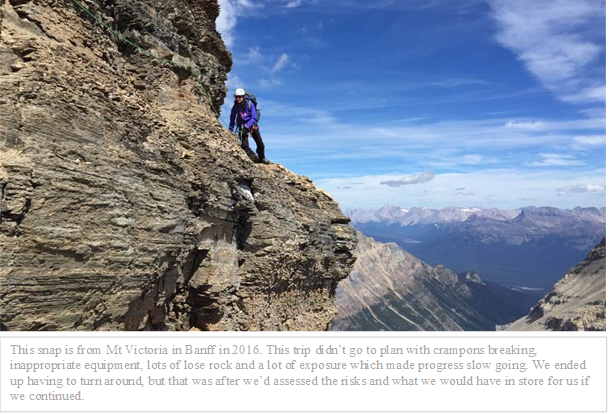
In the mountains, you are constantly exposed to danger (both objective and subjective hazards). This makes effective risk management the most important part of any trip.
It all starts with risk awareness. You’ve got to know your environment and constantly scan it. This is the same in business where your company is going to be in grave danger if you fail to identify threats and move quickly.
The next step is risk mitigation. Do the groundwork first and make sure you don’t take unnecessary risk. While you need to take risks in business, there is no point in going about it foolhardily. Before you take any risk, make sure you’ve done the homework first and have a support system to help prop you up if the risk doesn’t pay off. When you’re in the mountains, that means setting camps, having accessible emergency equipment and taking necessary precautions. Only after establishing a sound infrastructure, should you be comfortable about taking risks.
Lesson #5: S**t happens, deal with it
The distinguishing mark of true adventures, is that it is often no fun at all while you’re on one. The example that springs to mind in this instance is a crevasse fall I had while crossing the Bonar Glacier when attempting to climb Mt Aspiring in New Zealand in 2010. It had snowed a lot the night before and my climbing mate and I were inexperienced. We were roped up with me leading and all of the crevasses were covered over when I was swallowed by a crevasse. I ended up falling about 10 metres before landing on a ledge, which saved us from both disappearing into the crevasse. It took us about 3 hours to get me out and then we ran out of time to get back to the hut so we ended up sleeping out that night.
- Don’t let go – You typically find that your mind gives up before your body does
- When things go wrong – stay positive. See it as character building and an opportunity to develop your resilience. It’s how you handle yourself after something goes wrong that counts
- “Just keep going” – When something doesn’t go to plan, pick yourself up, remove yourself from danger, regroup and then keep moving forward
It’s the same in business. You will experience all sorts of setbacks, but you should not let it get you down. Stagnancy is not an option. Keep working hard and moving towards your destination. Even baby steps count towards achieving your vision.
Lesson #6: Seize the day and put the least possible trust in tomorrow
“In the end, we only regret the chances we didn’t take” – Lewis Carroll
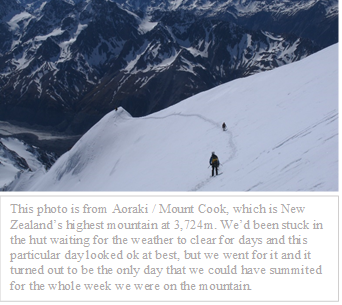
Seizing opportunities before they are gone is the only way you can reach the summit of some mountains. You have to take advantage of weather windows, particularly on mountain ranges that experience severe weather conditions, there may only be a few days a year that you can feasibly have a crack at the summit. The same is in business where if you don’t take up an opportunity, a competitor will and you’ll be left in their wake.
Commit – Reaching the top is a collection of steps. Sometimes the first step is the hardest when you know there are thousands of steps to go and it’s dark and freezing outside your tent. That’s why it’s so important to break your trip and days down into small, manageable increments and it’s the same in business with any large project. It would be daunting to embark on a business transformation project looking at it holistically, but broken down into small projects or functional groups and then further into project steps and milestones, makes it achievable and easier to commit and take that first step.
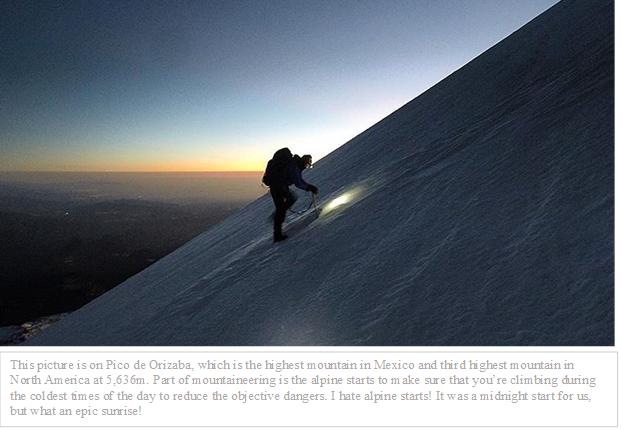
Lesson #7: It’s not about the summit, it’s about the journey to get there
The most fulfilling moments I have had when climbing, is not reaching the summit. It is when you are faced with some unforeseen challenge and you turn to your climbing partner with one of the most important of management questions: Now what?
Sometimes you must go backwards to go forwards – acclimatizing to big mountains thin air is a long and frustrating but necessary process to have a shot at reaching the summit. Climbers will typically climb from Basecamp up to Camp 1 and then come back down to Basecamp to sleep, before moving up to Camp 1.
“Failure” is always an option – know when to step back. Sometimes you’re turned around by weather, insufficient preparation, accidents or a team member unable to continue. It is simply not safe for you to continue climbing. Recently, Everest has a success rate of roughly 50%. So out of approximately 1,300 people that spend 2 months trying to climb Everest this year, only 641 people made it to the top. While we tend to reward people with perfect track records, sometimes it’s the people who stumbled and have taken risks that have the most to offer an organization. It’s important to give yourself and others room to fail. Often, those who have never failed have not pushed themselves enough.
Learn from your mistakes and enjoy the journey – Good judgment comes from experience.
Experience comes from bad judgment.
Lesson #8: If your dreams don’t scare you, they aren’t big enough
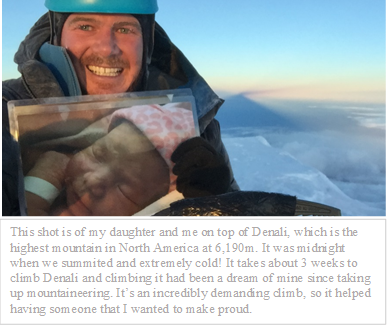 Dream big – It’s a cliche, but it’s true. You are going to need a deep level of commitment to reach the summit of
Dream big – It’s a cliche, but it’s true. You are going to need a deep level of commitment to reach the summit of
your mountain and overcome the obstacles you face in business.
Passion wins – Nothing great was ever achieved without enthusiasm. Your business needs passionate employees to be successful.
Focus on the “why” – Focus on forging a path that will take you to where you really want to go instead of chasing someone else’s goal.
Believe in your mission – You need to believe in the value of your mission and fiercely embrace it. It is the strength of your belief that generates the unshakable commitment you will possess to achieving these missions.
Nothing in this world that’s worth having comes easy
Now before you head out to the hills for your business education, it is important for you to know the three rules of mountaineering to prepare you for what lies ahead:
- It’s always further than it looks
- It’s always taller than it looks
- And it’s always harder than it looks
But that’s what makes it so rewarding!
Happy climbing!
